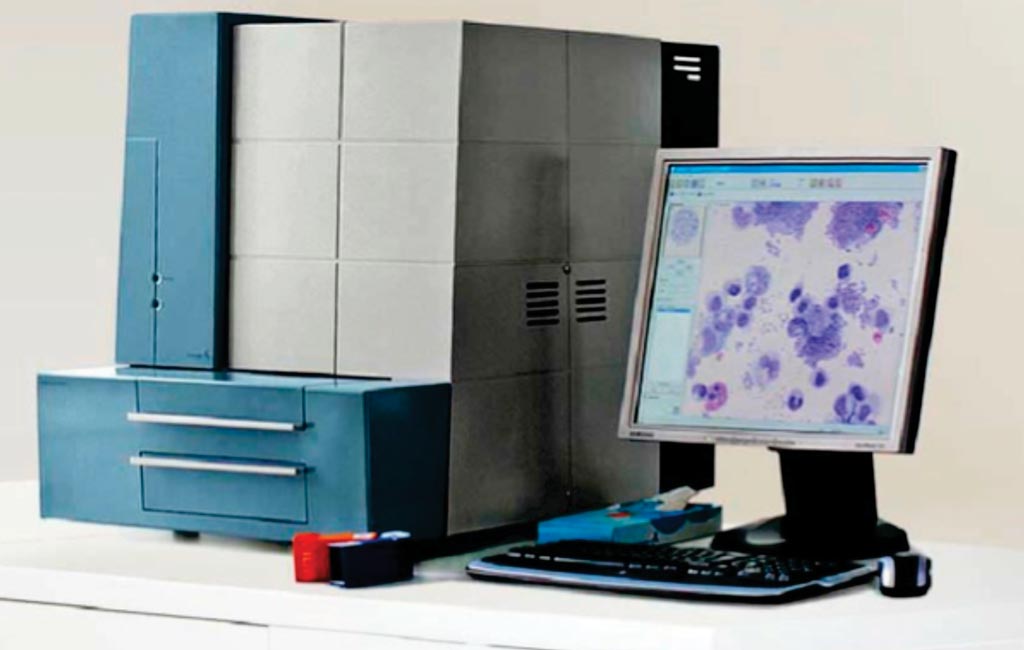Different Clinical Hematology Lab Configurations Compared
|
By LabMedica International staff writers Posted on 22 Apr 2019 |

Image: The CellaVision DM96 digital cell morphology system is designed to automate the time-consuming, manual effort associated with traditional microscopy (Photo courtesy of CellaVision).
Automated hematology analyzers are key clinical laboratory instruments that measure blood counts, identify subsets of nucleated blood cells, and flag specimens for further manual analysis. These analyzers range in price and functionality.
Examination of stained blood smears may be performed with a microscope or may be semi-automated with digital image analysis systems. The performance and costs of currently available analysis configurations with special focus on a proposed alternative using a minimal hematology analyzer plus a digital imaging device, allowing for remote oversight and interpretation has been compared.
Medical Laboratory scientists at the University of California, San Diego (La Jolla, CA, USA) and their colleagues used patient samples with orders for complete blood counts (CBCs) with white blood cell (WBC) differentials. During a 6-week period, a total of 206 blood samples were selected to represent a variety of clinical conditions, including samples with no abnormalities. The team wanted to determine whether low-volume laboratories might realize savings while gaining function by substituting commonly used configurations with a proposed alternative.
The investigators evaluated the performance of the proposed alternative configuration, blood counts with automated differentials produced by a Sysmex XE5000 (complete blood count reference method) were compared with cell counts from the Sysmex pocH-100i, CellaVision DM96 preclassified differentials, and DM96 reclassified differentials (differential reference method) by using standard regression analyses, 95% CIs, and truth tables. Financial cost modeling used staffing practices, test volumes, and smear production rates observed at remote clinics performing on-site hematology analysis.
The team reported that differential blood count parameters showed excellent correlation between the XE5000 and preclassification DM96. For blasts/abnormal cells, immature granulocytes, and nucleated red blood cells, the DM96 showed higher sensitivity and similar specificity to the XE5000. Cost modeling revealed that decreased personnel costs through remote monitoring of results facilitated by the DM96 would lead to lower operational costs relative to more conventional analysis configurations.
The authors concluded that the adoption of hematology analysis configurations including the CellaVision system at clinical sites with low to moderate daily testing volume (i.e., fewer than 100 tests per day) will likely lead to decreased costs, more efficient personnel utilization, and improved overall service (for example, decreased turnaround time and increased accuracy) as compared to configurations using either simple or complex hematology analyzers. The study was published on April 10, 2019, in the journal Archives of Pathology & Laboratory Medicine.
Related Links:
University of California, San Diego
Examination of stained blood smears may be performed with a microscope or may be semi-automated with digital image analysis systems. The performance and costs of currently available analysis configurations with special focus on a proposed alternative using a minimal hematology analyzer plus a digital imaging device, allowing for remote oversight and interpretation has been compared.
Medical Laboratory scientists at the University of California, San Diego (La Jolla, CA, USA) and their colleagues used patient samples with orders for complete blood counts (CBCs) with white blood cell (WBC) differentials. During a 6-week period, a total of 206 blood samples were selected to represent a variety of clinical conditions, including samples with no abnormalities. The team wanted to determine whether low-volume laboratories might realize savings while gaining function by substituting commonly used configurations with a proposed alternative.
The investigators evaluated the performance of the proposed alternative configuration, blood counts with automated differentials produced by a Sysmex XE5000 (complete blood count reference method) were compared with cell counts from the Sysmex pocH-100i, CellaVision DM96 preclassified differentials, and DM96 reclassified differentials (differential reference method) by using standard regression analyses, 95% CIs, and truth tables. Financial cost modeling used staffing practices, test volumes, and smear production rates observed at remote clinics performing on-site hematology analysis.
The team reported that differential blood count parameters showed excellent correlation between the XE5000 and preclassification DM96. For blasts/abnormal cells, immature granulocytes, and nucleated red blood cells, the DM96 showed higher sensitivity and similar specificity to the XE5000. Cost modeling revealed that decreased personnel costs through remote monitoring of results facilitated by the DM96 would lead to lower operational costs relative to more conventional analysis configurations.
The authors concluded that the adoption of hematology analysis configurations including the CellaVision system at clinical sites with low to moderate daily testing volume (i.e., fewer than 100 tests per day) will likely lead to decreased costs, more efficient personnel utilization, and improved overall service (for example, decreased turnaround time and increased accuracy) as compared to configurations using either simple or complex hematology analyzers. The study was published on April 10, 2019, in the journal Archives of Pathology & Laboratory Medicine.
Related Links:
University of California, San Diego
Latest Hematology News
- Platelet Activity Blood Test in Middle Age Could Identify Early Alzheimer’s Risk
- Microvesicles Measurement Could Detect Vascular Injury in Sickle Cell Disease Patients
- ADLM’s New Coagulation Testing Guidance to Improve Care for Patients on Blood Thinners
- Viscoelastic Testing Could Improve Treatment of Maternal Hemorrhage
- Pioneering Model Measures Radiation Exposure in Blood for Precise Cancer Treatments
- Platelets Could Improve Early and Minimally Invasive Detection of Cancer
- Portable and Disposable Device Obtains Platelet-Rich Plasma Without Complex Equipment
- Disposable Cartridge-Based Test Delivers Rapid and Accurate CBC Results
- First Point-of-Care Heparin Monitoring Test Provides Results in Under 15 Minutes

- New Scoring System Predicts Risk of Developing Cancer from Common Blood Disorder
- Non-Invasive Prenatal Test for Fetal RhD Status Demonstrates 100% Accuracy
- WBC Count Could Predict Severity of COVID-19 Symptoms
- New Platelet Counting Technology to Help Labs Prevent Diagnosis Errors
- Streamlined Approach to Testing for Heparin-Induced Thrombocytopenia Improves Diagnostic Accuracy
- POC Hemostasis System Could Help Prevent Maternal Deaths
- New Test Assesses Oxygen Delivering Ability of Red Blood Cells by Measuring Their Shape
Channels
Clinical Chemistry
view channel
Chemical Imaging Probe Could Track and Treat Prostate Cancer
Prostate cancer remains a leading cause of illness and death among men, with many patients eventually developing resistance to standard hormone-blocking therapies. These drugs often lose effectiveness... Read more
Mismatch Between Two Common Kidney Function Tests Indicates Serious Health Problems
Creatinine has long been the standard for measuring kidney filtration, while cystatin C — a protein produced by all human cells — has been recommended as a complementary marker because it is influenced... Read moreMolecular Diagnostics
view channel
Simple Urine Test to Revolutionize Bladder Cancer Diagnosis and Treatment
Bladder cancer is one of the most common and deadly urological cancers and is marked by a high rate of recurrence. Diagnosis and follow-up still rely heavily on invasive cystoscopy or urine cytology, which... Read more
Blood Test to Enable Earlier and Simpler Detection of Liver Fibrosis
Persistent liver damage caused by alcohol misuse or viral infections can trigger liver fibrosis, a condition in which healthy tissue is gradually replaced by collagen fibers. Even after successful treatment... Read moreImmunology
view channel
New Test Distinguishes Vaccine-Induced False Positives from Active HIV Infection
Since HIV was identified in 1983, more than 91 million people have contracted the virus, and over 44 million have died from related causes. Today, nearly 40 million individuals worldwide live with HIV-1,... Read more
Gene Signature Test Predicts Response to Key Breast Cancer Treatment
DK4/6 inhibitors paired with hormone therapy have become a cornerstone treatment for advanced HR+/HER2– breast cancer, slowing tumor growth by blocking key proteins that drive cell division.... Read more
Chip Captures Cancer Cells from Blood to Help Select Right Breast Cancer Treatment
Ductal carcinoma in situ (DCIS) accounts for about a quarter of all breast cancer cases and generally carries a good prognosis. This non-invasive form of the disease may or may not become life-threatening.... Read moreMicrobiology
view channel
Rapid Diagnostic Test Matches Gold Standard for Sepsis Detection
Sepsis kills 11 million people worldwide every year and generates massive healthcare costs. In the USA and Europe alone, sepsis accounts for USD 100 billion in annual hospitalization expenses.... Read moreRapid POC Tuberculosis Test Provides Results Within 15 Minutes
Tuberculosis remains one of the world’s deadliest infectious diseases, and reducing new cases depends on identifying individuals with latent infection before it progresses. Current diagnostic tools often... Read more
Rapid Assay Identifies Bloodstream Infection Pathogens Directly from Patient Samples
Bloodstream infections in sepsis progress quickly and demand rapid, precise diagnosis. Current blood-culture methods often take one to five days to identify the pathogen, leaving clinicians to treat blindly... Read morePathology
view channel
Tunable Cell-Sorting Device Holds Potential for Multiple Biomedical Applications
Isolating rare cancer cells from blood is essential for diagnosing metastasis and guiding treatment decisions, but remains technically challenging. Many existing techniques struggle to balance accuracy,... Read moreAI Tool Outperforms Doctors in Spotting Blood Cell Abnormalities
Diagnosing blood disorders depends on recognizing subtle abnormalities in cell size, shape, and structure, yet this process is slow, subjective, and requires years of expert training. Even specialists... Read moreTechnology
view channel
Artificial Intelligence Model Could Accelerate Rare Disease Diagnosis
Identifying which genetic variants actually cause disease remains one of the biggest challenges in genomic medicine. Each person carries tens of thousands of DNA changes, yet only a few meaningfully alter... Read more
AI Saliva Sensor Enables Early Detection of Head and Neck Cancer
Early detection of head and neck cancer remains difficult because the disease produces few or no symptoms in its earliest stages, and lesions often lie deep within the head or neck, where biopsy or endoscopy... Read moreIndustry
view channel
Abbott Acquires Cancer-Screening Company Exact Sciences
Abbott (Abbott Park, IL, USA) has entered into a definitive agreement to acquire Exact Sciences (Madison, WI, USA), enabling it to enter and lead in fast-growing cancer diagnostics segments.... Read more























